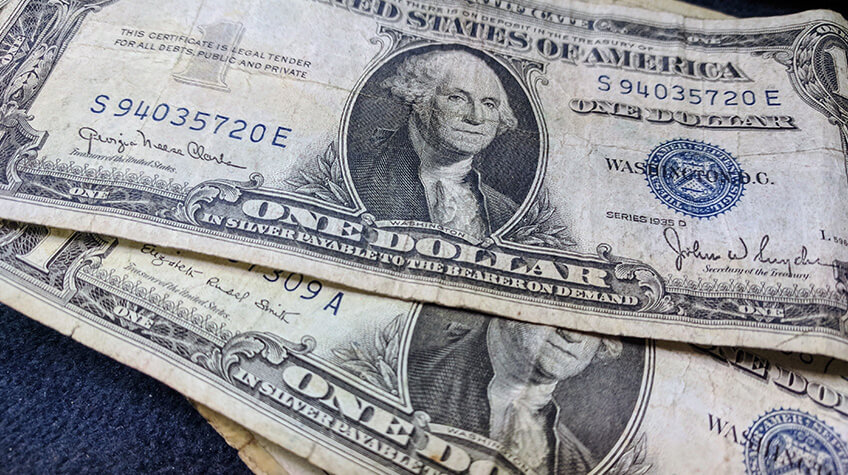Bring in and Sell your USA Bills & Currency in Las Vegas & Henderson
We buy old & collectible currency & paper bills. When it comes to the newer money, that is still in heavy circulation, and not that collectible, we only pay face value minus our commission. In some cases, it is best to just to go a real money changer. However, if you are unsure how valuable your paper currency is, bring it down for a free evaluation.
History of United state bills
The history of the US dollar refers to quite 240 years since the Congress of the US licensed the supply of Continental Currency in 1775. On Apr a pair of, 1792, the US Congress created the US greenback because of the country’s commonplace unit of cash.
Before the finish of 1778, Continental Currency held just between 1⁄5 to 1⁄7 of its unique face esteem. By 1780, Continental bills – or Continentals – were worth only 1⁄40 of their face esteem. Congress endeavored to change the money by expelling the old bills from a low and issuing new ones, yet this met with next to zero achievements. By May 1781, Continentals had turned out to be so useless they stopped to circle as cash. Benjamin Franklin noticed that the deterioration of the money had, basically, went about as a duty to pay for the war. In the 1790s, after the sanction of the United States Constitution, Continentals could be traded for treasury bonds at 1% of face esteem.
Congress designated Robert Morris to be Superintendent of Finance of the United States following the fall of the Continental cash. In 1782, Morris pushed the production of the main budgetary organization contracted by the United States. The Bank of North America was financed to some extent by specie credited to the United States by France. Morris helped fund the last phases of the war by issuing notes in his name, supported by his own cash. The Bank of North America additionally issued notes convertible into specie. On July 6, 1785, the Continental Congress of the United States approved the issuance of another cash, the US dollar.
Be that as it may, runaway expansion and the fall of the Continental cash incited delegates at the Constitutional Convention in Philadelphia in 1787 to incorporate the gold and silver proviso in the United States Constitution, keeping singular States from issuing their own bills of credit. Article One states they were precluded to “make anything besides gold and silver Coin a Tender in Payment of Debts.” Some individuals utilize this proviso to contend that government paper cash is illegal.
The United States Mint was made by Congress following the death of the Coinage Act of 1792. It was basically entrusted with creating and coursing coinage. The principal Mint building was in Philadelphia, at that point the capital of the United States. The Mint was initially set inside the Department of State, until the point when the Coinage Act of 1873 when it turned out to be a piece of the Department of the Treasury (in 1981 it was put under the support of the Treasurer of the United States). The Mint had the specialist to vary over any valuable metals into normal coinage for anybody’s record with no fee charge past processing prices.
United State Currency
1. Continental Currency (1775-1790)
To fund the Revolutionary War, the Continental Congress issued paper cash, sponsored by the “expectation” of assessment incomes. It was the main governmentally issued paper cash. Without strong sponsorship and effectively duplicated, the Continental cash notes rapidly ended up debased, offering to ascend to the expression “not worth a Continental.” The mainland money devalued quickly, ending up for all intents and purposes useless before the finish of the war.
2. Silver Coins (1792-1863)
Congress passed the primary Coinage Act in 1792 giving the United States Mint duty regarding making coins for open utilize. A silver coin is generally 90% silver with the staying 10% of copper for quality. The law guided cash to be produced using copper, silver, and gold. Today, these coins (quarters and dimes) are involved in 75% copper and 25% nickel amalgam.
3. Gold Coins (1795-Present)
In 1795, the primary authority on gold coins was printed in the United States. At the point when gold was found in California in 1948, two new sections were struck, the gold dollar and the twofold hawk. Well known among gatherers, present-day gold coins are utilized fundamentally for speculation purposes.
4. Texas Dollar (1837-1840)
The Republic of Texas first issued paper cash in 1837. This cash was called “Star Money” for the little star on the substance of the bill. The Star Money was not confronting esteem cash, yet rather enthusiasm bearing notes (like a Treasury Bill) that circled by being supported over to the following payee. In 1838, Texas issued change notes with expounding plans on the front and clear backs. The supposed Texas “Redbacks” were issued in 1839 with the name originating from the ruddy shade of the back of the bills.
5. State Bank Notes (1837-1863)
Issued by state-sanctioned, private banks, State Bank Notes turned into the overwhelming type of money after 1836. With in excess of 7,000 assortments of shading and outline, they were effectively forged, causing disarray and course issues, No government directions in regards to keeping money existed, making what is alluded to as the Free Banking Era. In light of people in general’s absence of trust in the managing an accounting industry, there were far-reaching bank disappointments amid this time as the general population expelled their assets from the banks. In the long run, Congress required an expense on State Bank Notes that diminished their esteem, until the point when they were in the long run eliminated of dissemination.
6. Confederate Currency (1861-1864)
Amid the Civil War, the Confederacy printed and issued notes from the Treasury of its recently framed government. The Confederate States of America dollar was first issued just before the flare-up of the Civil War. It was not sponsored by substantial resources, but rather essentially by a guarantee to pay the conveyor after the war. As the war tilted against the Confederates, trust in the money lessened, and swelling took after. Before the finish of 1864, the money was for all intents and purposes useless.
7. Fractional Currency (1862-1872)
Partial cash, additionally alluded to as “paper coins” and “shinplasters” (as the nature of the paper was poor to the point that with a touch of starch it could be utilized to make paper mache-like mortars to be utilized to treat injured legs), was presented by the United States government following the flare-up of the Civil War. These partial notes were being used in the vicinity of 1862 and 1876 and issued in 3-, 5-, 10-, 15-, 25-, and 50-penny divisions. Partial money was utilized to give change when individuals were accumulating gold and silver.
8. Demand Notes (1861-1917)
To fund the Civil War, the U.S. Treasury issued paper cash without precedent for the type of non-enthusiasm bearing notes, prominently called “greenbacks” because of the particular green ink. The U.S. government set request notes into a course and utilized them to pay compensations and costs acquired amid the Civil War.
9. National Bank Notes 91863-1935)
Supported by United States bonds, these notes were issued by national banks and contracted by the United States government. State banks issued their own particular notes preceding the Civil War, yet in 1863, the National Banking Act built up an arrangement of national banks. The new banks issued these nationally certified receipts with government oversight. This money was now and then called “main residence” notes, because of the extensive variety of towns and urban communities that issued them.
10. Gold Certificates (1865-1933)
In the first place approved by the United States government, gold endorsements were first imprinted in 1865, sponsored by gold coin and bullion stores. These were first for the selective use as exchanges between banks. In 1882, a general-course gold endorsement was issued. A gold authentication was an archive that demonstrated responsibility for, without individuals storing the real gold. At a rate of $20.67 per troy ounce set up by the Coinage Act of 1834, these gold endorsements were utilized as genuine money, redeemable for merchandise and enterprises. The Gold Reserve Act of 1933 required the surrender of every single gold declaration, rendering them out of date. Be that as it may, it is lawful to gather them today as confinements were evacuated in 1964.
11. Silver Certificates (1878-1963)
The Coinage Act of 1873 made standard silver dollars quit being delivered. The Treasury printed out promissory notes on paper that were lawful delicate redeemable in silver dollars. These were silver authentications, printed from 1878 to 1963 and were upheld by silver bullion acquired by the U.S. Treasury. Reclamation for silver finished on June 24, 1968, with a huge number of unredeemed silver declarations still available for use.
12. Federal Reserve Bank Notes (1913-1935)
Central Bank Notes were first approved by Congress in 1913 when the Federal Reserve System was built up. These notes were commitments of the particular Federal Reserve Banks named on the substance of the note. The issuance was ceased in 1935. Central Bank Notes contrast from Federal Reserve Notes in that they are supported by one of the 12 Federal Reserve Banks, as opposed to by all in all. They were upheld correspondingly to national monetary orders, utilizing U.S. bonds, however by Federal Reserve Banks rather than contracted national banks. Central Bank Notes are never again issued. The main U.S. banknotes still underway are Federal Reserve Notes.
13. Federal Reserve Notes (1913-Present)
Central bank Notes were presented with the Federal Reserve Act of 1913 to help advance a focal saving money framework. Central bank Notes involve over 99% of the present paper cash and are as of now issued in categories of $1, $2, $5, $10, $10, $50, and $100. Before 1945, Federal Reserve Notes were likewise imprinted in sections up to $10,000, yet the bigger bills were resigned in 1969 because of the absence of interest. The Federal Reserve does not print cash or mint coins. It goes about as a holding office and merchant for the Bureau of Engraving and Printing and the United States Mint.
Related Categories:
To know the value of your USA Bills & Currency bring it to Nevada Coin Mart for a free verbal appraisal and evaluation today!
References:
- https://www.uscurrency.gov/history
- https://en.wikipedia.org/wiki/History_of_the_United_States_dollar












































